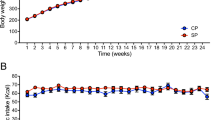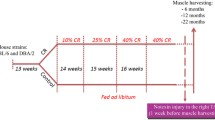Abstract
To study the role of insulin-like growth factors (IGFs) in the atrophy of mouse masseter muscle in response to a change from a hard to a soft diet, we analyzed the amounts of mRNA and the immunolocalization for IGF-I, IGF-II, their receptors (IGFRs), and binding proteins (IGFBPs). Sixteen male ICR mice were fed a hard diet after weaning; they were divided into two groups at 6 months of age and fed a hard or a soft diet for 1 week. The soft diet treatment decreased masseter weight by 19% (P<0.01) and the minimal diameter of masseter myofibers by 19% (P<0.01), verifying that a soft diet led to atrophy of mouse masseter muscle. The soft diet treatment induced a 30% reduction in the amount of IGF-I mRNA (P<0.05) in preparations of whole masseter tissues. Immunohistochemical findings suggested that a reduction in the expression of IGF-I protein took place in the neural tissues, not in the masseter myofibers. The soft diet treatment induced a 56% decrease in IGF-II mRNA (P<0.05), a 21% increase in IGFR2 mRNA (P<0.01), and a 38% decrease in IGFBP5 mRNA (P<0.01). Immunohistochemical results suggested that these changes at the protein level occurred in the masseter myofibers. No significant or marked difference in the mRNA amount or immunostaining pattern for IGFR1, IGFBP3, IGFBP4, or IGFBP6 was found between the soft and hard diet groups. No IGFBP1 or IGFBP2 mRNA was detected. Thus, IGF-I, IGF-II, IGFR2, and IGFBP5 seem to play a role in the atrophy of mouse masseter muscle in response to the change from a hard to a soft diet in an autocrine and/or paracrine manner.








Similar content being viewed by others
References
Adams GR, Haddad F, Baldwin KM (1999) Time course of changes in markers of myogenesis in overloaded rat skeletal muscles. J Appl Physiol 87:1705–1712
Adams GR, McCue SA, Bodell PW, Zeng M, Baldwin KM (2000) Effects of spaceflight and thyroid deficiency on hindlimb development. I. Muscle mass and IGF-I expression. J Appl Physiol 88:894–903
Awede B, Thissen J-P, Gailly P, Lebacq J (1999) Regulation of IGF-I, IGFBP-4 and IGFBP-5 gene expression by loading in mouse skeletal muscle. FEBS Lett 461:263–267
Awede BL, Thissen J-P, Lebacq J (2002) Role of IGF-I and IGFBPs in the changes of mass and phenotype induced in rat soleus muscle by clenbuterol. Am J Physiol Endocrinol Metab 282:E31–E37
Bayol S, Loughna PT, Brownson C (2000) Phenotypic expression of IGF binding protein transcripts in muscle, in vitro and in vivo. Biochem Biophys Res Commum 273:282–286
Criswell DS, Booth FW, DeMayo F, Schwartz RJ, Gordon SE, Fiorotto ML (1998) Overexpression of IGF-I in skeletal muscle of transgenic mice does not prevent unloading-induced atrophy. Am J Physiol 275:E373–E379
Czerwinski SM, Martin JM, Bechtel PJ (1994) Modulation of IGF mRNA abundance during stretch-induced skeletal muscle hypertrophy and regression. J Appl Physiol 76:2026–2030
DeVol DL, Rotwein P, Sadow JL, Novakofski J, Bechtel PJ (1990) Activation of insulin-like growth factor gene expression during work-induced skeletal muscle growth. Am J Physiol 259:E89–E95
Ewton DZ, Falen SL, Florini JR (1987) The type II insulin-like growth factor (IGF) receptor has low affinity for IGF-I analogs: pleiotypic actions of IGFs on myoblasts are apparently mediated by the type I receptor. Endocrinology 120:115–123
Ewton DZ, Coolican SA, Mohan S, Chernausek SD, Florini JR (1998) Modulation of insulin-like growth factor actions in L6A1 myoblasts by insulin-like growth factor binding protein (IGFBP)-4 and IGFBP-5: A dual role for IGFBP-5. J Cell Physiol 177:47–57
Ferguson MWJ, Sharpe PM, Thomas BL, Beck F (1992) Differential expression of insulin-like growth factors I and II (IGF I and II), mRNA, peptide and binding protein 1 during mouse palate development: comparison with TGFβ peptide distribution. J Anat 181:219–238
Florini JR, Ewton DZ, Coolican SA (1996) Growth hormone and the insulin-like growth factor system in myogenesis. Endocr Rev 17:481–517
Foulstone EJ, Savage PB, Crown AL, Holly JMP, Stewart CEH (2003) Role of insulin-like growth factor binding protein-3 (IGFBP-3) in the differentiation of primary human adult skeletal myoblasts. J Cell Physiol 195:70–79
Goldspink G (1999) Changes in muscle mass and phenotype and the expression of autocrine and systemic growth factors by muscle in response to stretch and overload. J Anat 194:323–334
Jones JI, Clemmons DR (1995) Insulin-like growth factors and their binding proteins: biological actions. Endocr Rev 16:3–34
Kiess W, Haskell JF, Lee L, Greenstein LA, Miller BE, Aarons AL, Rechler MM, Nissley SP (1987) An antibody that blocks insulin-like growth factor (IGF) binding to the type II IGF receptor is neither an agonist nor an inhibitor of IGF-stimulated biologic responses in L6 myoblasts. J Biol Chem 262:12745–12751
Kiliaridis S, Engstrom C, Thilander B (1988) Histochemical analysis of masticatory muscle in the growing rat after prolonged alteration in the consistency of the diet. Arch Oral Biol 33:187–193
Lalani R, Bhasin S, Byhower F, Tarnuzzer R, Grant M, Shen R, Asa S, Ezzat S, Gonzalez-Cadavid NF (2000) Myostatin and insulin-like growth factor-I and -II expression in the muscle of rats exposed to the microgravity environment of the Neurolab space shuttle flight. J Endocrinol 167:417–428
Langenbach G, Pavert S van de, Savalle W, Korfage H, Eijden T van (2003) Influence of food consistency on the rabbit masster muscle fibres. Eur J Oral Sci 111:81–84
Ludwig T, Eggenschwiler J, Fisher P, D’Ercole AJ, Davenport ML, Efstratiadis A (1996) Mouse mutants lacking the type 2 IGF receptor (IGF2R) are rescued from perinatal lethality in Igf2 and Igf1r null backgrounds. Dev Biol 177:517–535
Maeda N, Kawasaki T, Osawa K, Yamamoto Y, Sumida H, Masuda T, Kumegawa M (1987) Effects of long-term intake of a fine-grained diet on the mouse masseter muscle. Acta Anat 128:326-333
Navarro M, Barenton B, Garandel V, Schnekenburger J, Bernardi H (1997) Insulin-like growth factor I (IGF-I) receptor overexpression abolishes the IGF requirement for differentiation and induces a ligand-dependent transformed phenotype in C2 inducible myoblasts. Endocrinology 138:5210–5219
Ohnuki Y, Saeki Y, Yamane A, Yanagisawa K (2000) Quantitative changes in the mRNA for contractile proteins and metabolic enzymes in masseter muscle of bite-opened rats. Arch Oral Biol 45:1025–1032
Owino V, Yang SY, Goldspink G (2001) Age-related loss of skeletal muscle function and the inability to express the autocrine form of insulin-like growth factor-1 (MGF) in response to mechanical overload. FEBS Lett 505:259–263
Quinn LS, Steinmetz B, Maas A, Ong L, Kaleko M (1994) Type-1 insulin-like growth factor receptor overexpression produces dual effects on myoblast proliferation and differentiation. J Cell Physiol 159:387–398
Ringqvist M (1974) Fiber types in human masticatory muscles. Relation to function. Scand J Dent Res 82:333–355
Saito T, Akutsu S, Urushiyama T, Ishibashi K, Nakagawa Y, Shuler CF, Yamane A (2003) Changes in the mRNA expressions of insulin-like growth factors, their receptors, and binding proteins during the postnatal development of rat masseter muscle. Zool Sci 20:441–447
Wang Z-Q, Fung MR, Barlow DP, Wagner EF (1994) Regulation of embryonic growth and lysosomal targeting by the imprinted Igf2/Mpr gene. Nature 372:464–467
Yamane A, Takahashi K, Mayo M, Vo H, Shum L, Zeichner-David M, Slavkin HC (1998) Induced expression of MyoD, myogenin and desmin during myoblast differentiation in embryonic mouse tongue development. Arch Oral Biol 43:407–416
Yamane A, Mayo M, Shuler C, Crowe D, Ohnuki Y, Dalrymple K, Saeki Y (2000) Expression of myogenic regulatory factors during the development of mouse tongue striated muscle. Arch Oral Biol 45:71–78
Yamane A, Urushiyama T, Diekwisch TGH (2002) Roles of insulin-like growth factors and their binding proteins in the differentiation of mouse tongue myoblasts. Int J Dev Biol 46:807–816
Yang S, Alnaqeeb M, Simpson H, Goldspink G (1997) Changes in muscle fibre type, muscle mass and IGF-I gene expression in rabbit skeletal muscle subjected to stretch. J Anat 190:613–622
Acknowledgements
We thank Professor M. Chiba, Tsurumi University School of Dental Medicine, for his support and encouragement throughout the present study. We are also grateful to Professor T. Sato, Tsurumi University School of Dental Medicine, for his useful suggestions.
Author information
Authors and Affiliations
Corresponding author
Additional information
Part of the present study was supported by a grant-in-aid for funding scientific research (no. 13671955), Bio-ventures and High-Technology Research Center, from the Ministry of Education, Culture, Sports, Science, and Technology of Japan
Rights and permissions
About this article
Cite this article
Urushiyama, T., Akutsu, S., Miyazaki, JI. et al. Change from a hard to soft diet alters the expression of insulin-like growth factors, their receptors, and binding proteins in association with atrophy in adult mouse masseter muscle. Cell Tissue Res 315, 97–105 (2004). https://doi.org/10.1007/s00441-003-0787-0
Received:
Accepted:
Published:
Issue Date:
DOI: https://doi.org/10.1007/s00441-003-0787-0




